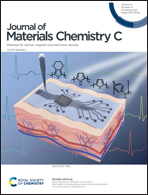Organic electrochemical transistors – from device models to a targeted design of materials
Abstract
Organic electrochemical transistors (OECTs) are highly versatile in terms of their form factor, fabrication approach that can be applied, and freedom in the choice of substrate material. Their ability to transduce ionic into electric signals and the use of bio-compatible organic materials makes them ideally suited for a wide range of applications, in particular in areas where electronic circuits are interfaced with biologic matter. OECT technology has attracted widespread interest in recent years, which has been accompanied by a steady increase in its performance. However, this progress was mainly driven by device optimization and less by targeting the design of new device geometries and OECT materials. To narrow this gap, this review provides an overview on the different device models that are used to explain the underlying physics governing the steady and transient behavior of OECTs. We show how the models can be used to identify synthetic targets to produce higher performing OECT materials and summarize recently reported materials classes. Overall, a road-map of future research in new device models and material design is presented summarizing the most pressing open questions in the understanding of OECTs.



 Please wait while we load your content...
Please wait while we load your content...